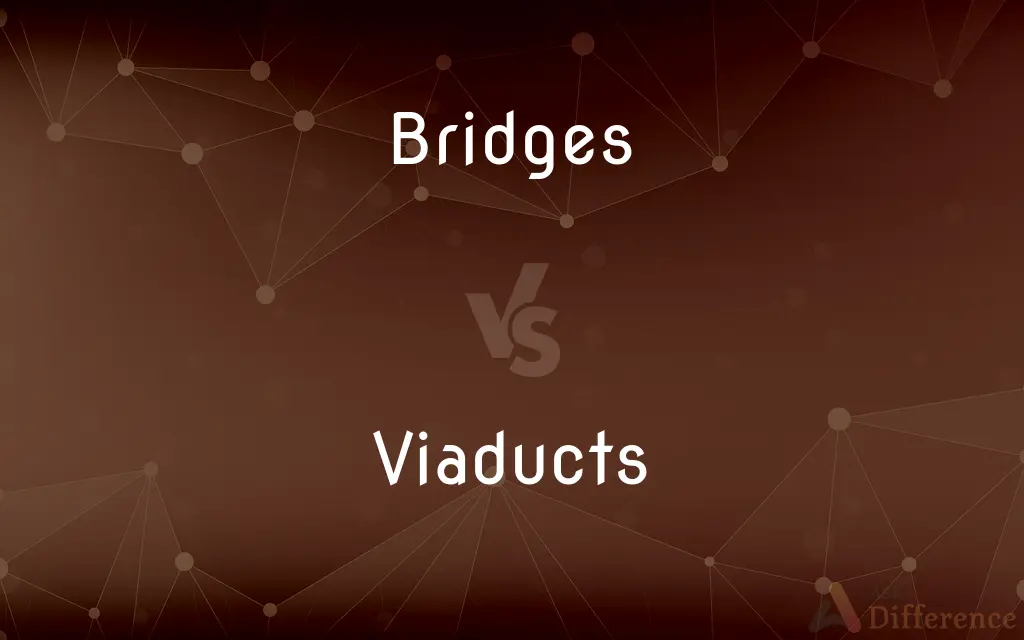Bridges vs. Viaducts — What's the Difference?
By Tayyaba Rehman — Published on January 28, 2024
Bridges span physical obstacles like rivers, connecting two points, while viaducts are long, elevated bridges, typically carrying roads or railways over valleys or other roadways.

Difference Between Bridges and Viaducts
Table of Contents
ADVERTISEMENT
Key Differences
Bridges are structures built to span physical obstacles, such as rivers, valleys, or roads, for the purpose of providing passage over them. They vary in design, ranging from simple wooden structures to elaborate architectural pieces. Viaducts, a specific type of bridge, are typically long and elevated, often used to carry a road or railway over a series of obstacles like valleys, roads, or water.
The primary function of bridges is to connect two points across an obstacle, which could be a body of water, a road, or a valley. Their design focuses on efficiently spanning the shortest distance possible between these points. Viaducts, however, are designed for length and elevation, aiming to maintain a consistent level over uneven terrain, making them ideal for transportation routes.
In terms of construction, bridges often involve diverse materials and designs, such as suspension, arch, or beam bridges, depending on the span and the nature of the obstacle. Viaducts are characteristically a series of small spans supported by many towers or piers, creating a continuous elevated path, commonly seen in elevated railways or highways.
Architecturally, bridges can be significant landmarks, showcasing engineering prowess and aesthetic values. Viaducts, while also impressive engineering feats, are more utilitarian, often designed to blend into the landscape or provide the most practical route for transportation.
Lastly, in urban and historical contexts, bridges often have cultural and symbolic significance, representing connectivity and progress. Viaducts, being predominantly functional, symbolize industrial and transportation advances, particularly in the context of rail and highway infrastructure.
ADVERTISEMENT
Comparison Chart
Primary Purpose
Spanning physical obstacles like rivers, roads
Carrying roads or railways over long distances
Design Focus
Efficient crossing, diverse designs
Length and elevation, series of small spans
Construction
Various materials and types
Many towers or piers for support
Architectural Role
Often landmarks, diverse aesthetic values
Utilitarian, blending into landscape
Cultural Significance
Symbolize connectivity and progress
Represent industrial and transportation advances
Compare with Definitions
Bridges
Structures that span physical obstacles.
The Golden Gate Bridge is an iconic structure in San Francisco.
Viaducts
Long, elevated bridges for transportation.
The Millau Viaduct in France is one of the tallest in the world.
Bridges
Vary in design and materials.
The city has several bridges, including suspension and beam types.
Viaducts
Functional, often blending into landscapes.
The rural viaduct was designed to blend with the surrounding hills.
Bridges
Connect two points across an obstacle.
A new bridge was built to improve connectivity between the two towns.
Viaducts
Symbolize transportation advances.
This viaduct represents a major advancement in our railway system.
Bridges
Often have cultural significance.
Bridges in the city symbolize architectural progress and innovation.
Viaducts
Designed for length and elevation.
The viaduct spans the entire valley, maintaining a consistent level.
Bridges
Can be significant landmarks.
The Brooklyn Bridge is not only functional but also a historical landmark.
Viaducts
Feature many supports or piers.
The long viaduct is supported by a series of concrete piers.
Bridges
Plural of bridge
Viaducts
A series of spans or arches used to carry a road or railroad over a wide valley or over other roads or railroads.
Viaducts
Plural of viaduct
Common Curiosities
How are bridges different in design from viaducts?
Bridges have diverse designs; viaducts are a series of small spans on towers or piers.
What is a viaduct?
A long, elevated bridge, often used for roads or railways.
What is a bridge?
A structure built to span an obstacle like a river or road.
What materials are used in bridge construction?
Materials like steel, concrete, wood, depending on the type and purpose.
Can bridges be used for railways?
Yes, bridges can carry railways, roads, or pedestrian paths.
Can a bridge be an architectural landmark?
Absolutely, many bridges are famous for their architectural beauty.
Are viaducts used in urban areas?
Yes, especially for elevated roads or trains.
How long can bridges span?
It varies; some bridges span miles, like suspension bridges.
Do viaducts support heavy loads?
Yes, they're designed to support heavy transportation loads.
Can bridges be considered works of art?
Many bridges are indeed considered architectural and artistic marvels.
What's the primary purpose of a viaduct?
To carry traffic over long distances, especially over uneven terrain.
Do viaducts have cultural significance?
They're more functional, symbolizing transportation progress.
Are all viaducts elevated?
Yes, they're typically elevated structures.
Are viaducts more expensive than regular bridges?
Often yes, due to their length and the amount of material required.
What role do bridges play in connectivity?
They connect regions separated by physical obstacles.
Share Your Discovery

Previous Comparison
14 SEER vs. 13 SEER
Next Comparison
HTML 4 vs. HTML 5Author Spotlight
Written by
Tayyaba RehmanTayyaba Rehman is a distinguished writer, currently serving as a primary contributor to askdifference.com. As a researcher in semantics and etymology, Tayyaba's passion for the complexity of languages and their distinctions has found a perfect home on the platform. Tayyaba delves into the intricacies of language, distinguishing between commonly confused words and phrases, thereby providing clarity for readers worldwide.
















































